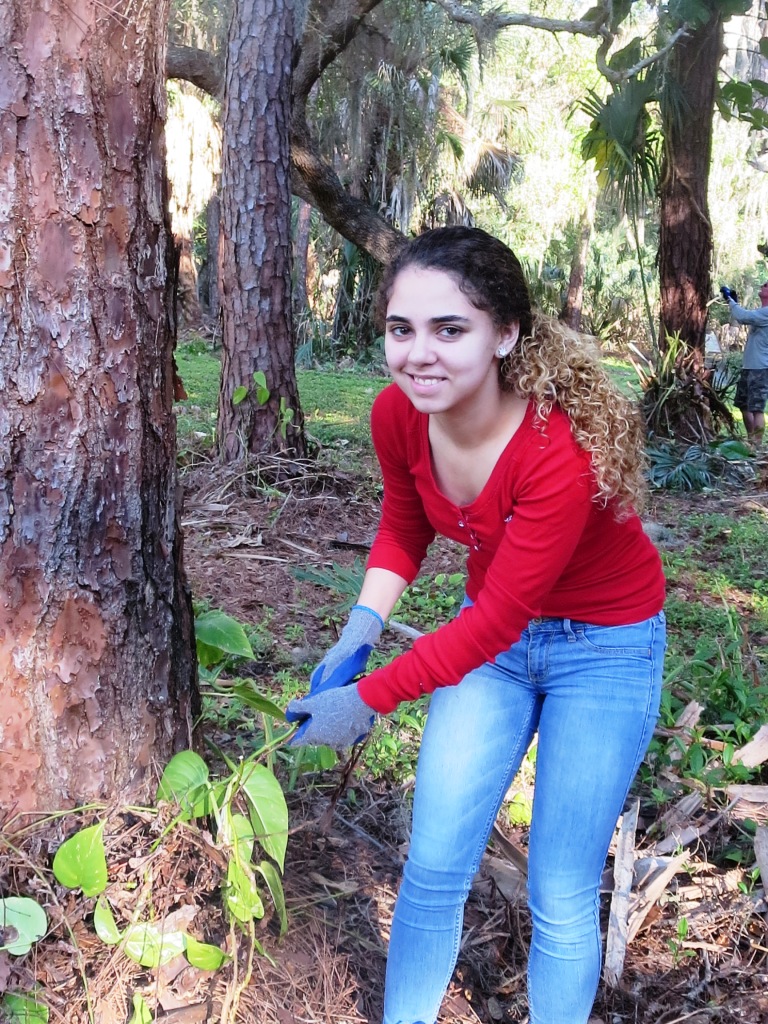
Help Us Chart A Healthy
Future for Tampa Bay
Beginning this year, we are revising our management plan for Tampa Bay, called "Charting The Course," for the first time in a decade. We'll update, add or consolidate priority actions addressing a wide range of issues, from water quality and habitat restoration to public access. The final document will guide bay restoration, research and education efforts for TBEP and its partners for the coming decade.
You can help us by taking our short Bay Opinion Poll on how you enjoy the bay and how you feel about the bay's health, now and in the future. It will only take you about 5 minutes -- or less!
You can also let us know via the poll whether you want to review drafts of our priority actions as we complete them. Final approval of the entire document is anticipated in early 2017.
|

|
|
TBEP Awards $83,000 in Community Mini-Grants
|
|
|
Volunteers used grant funds to help restore a stormwater pond at the Lake Forest neighborhood in Pinellas Park last year.
|
The Tampa Bay Estuary Program recently awarded $83,000 to 20 community groups for projects that directly involve citizens in restoring and improving Tampa Bay.
Click here to see a complete list of recipients and their projects.
This year's Bay Mini-Grant program attracted 30 applicants. Members of the Estuary Program's Community Advisory Committee evaluated the grant proposals, recommending 20 for full funding. Grant requests were eligible for as little as $500 up to $5,000.
Funding for the grants comes from sales of the Tampa Bay Estuary license plate.
|
|
TBEP Staff On The Go
 TBEP Director Holly Greening and husband Gerold vacationed in Belize and Guatemala in January, where they enjoyed some outstanding bird-watching and snorkeling. Gerold photographed the keel-billed toucan pictured above. Environmental Science and Policy Manager Lindsay Cross is a proud member of the 2015 class of Leadership St. Pete (LSP). A program of the St. Petersburg Area Chamber of Commerce, LSP informs, engages and nurtures future community leaders. Lindsay helped to organized a trip for her classmates to Tallahassee in March to visit with local legislators and discuss community issues.  Holly and TBEP Senior Scientist Ed Sherwood got a glimpse of what winter was like for those outside the Sunshine State when they attended the National Estuary Program's annual workshop in Washington, D.C. in February. Ed also ventured north again in March for the Interagency Conference on Research in Watersheds in Charleston. The conference brought together various federal agencies working on watershed-related issues. |
|  |
|
| |
2014 Report: Water Quality in Tampa Bay Gets A Green Light For Third Straight Year
All major segments of Tampa Bay met water quality goals in 2014, for the third year in a row. This marks the first time since monitoring began that water quality in all four major bay segments met targets for three consecutive years.

The rating system considers the amount of microscopic algae in the water (as indicated by chlorophyll-a, a plant pigment), as well as the amount of visible sunlight penetrating the water column.
"Green" means a bay segment is meeting water quality targets, while "red" means it is not. "Yellow" indicates that the area bears watching.
The 2014 analysis shows a green light across the board for all four major bay segments: Hillsborough Bay, Old Tampa Bay, Middle Tampa Bay, and Lower Tampa Bay. This means that water quality is good enough to foster continued recovery of underwater seagrasses.
Since 1999, seagrasses have been expanding on the bay bottom at a rate of 738 acres per year.
The toxic algae
Pyrodinium bahamense was reported in Old Tampa Bay during summer 2014, but the blooms were not severe enough to affect annual water quality results. Likewise, a non-harmful bloom of
Neoceratium hircus algae in Hillsborough Bay in September fueled by runoff from the Alafia River did not alter overall results for this segment.
The data used for the report card is collected monthly by the Environmental Protection Commission of Hillsborough County, from 45 sampling stations all over the bay.
|
Read our Progress Report Online

Check out our brand-new Progress Report to the Public to learn about the research, restoration and education projects we've been working on for the last three years!
Click here to read it.
|
A Fond Farewell
We were pleased to honor two of our most dedicated supporters recently as they move on to new chapters in their lives.

TBEP Executive Director Holly Greening, left, presented Tampa City Councilmember Mary Mulhern a beautiful photo of a roseate spoonbill by Dave Kandz at a recent Tampa City Council meeting. Ms. Mulhern served on our Policy Board from 2011-2015, and was instrumental in Tampa's passage of a strong residential fertilizer ordinance to protect the bay and the Hillsborough River.
Craig Kovach, formerly of CF Industries and most recently The Mosaic Company, was given a "Champion of the Bay" award in February for his role as a consensus-builder in fostering industry participation in our Nitrogen Management Consortium. Craig was involved with TBEP for two decades. He is now enjoying a well-deserved retirement in Belize!
|
|
"Give A Day For The Bay"
Some 30 volunteers, including Clearwater Mayor George Cretekos (front row, second from right) gathered at Moccasin Lake Nature Park in Clearwater on January 10 to round up invasive rosary pea, air potatoes and Caesar weed - a trifecta of invasives. Gardens and overgrown areas got some attention along with trash and debris removal along the park trails.
 And, on March 21, nearly 50 volunteers, including this student from St. Petersburg High School, tackled invasive vines and Brazilian pepper trees at Boyd Hill Nature Park in St. Pete.
Our final workday of the Spring 2015 season will be May 2 at Robinson Preserve in Bradenton. Volunteers are needed to create oyster bags using clean oyster shell to help prevent shoreline erosion and provide habitat. This workday is a joint Tampa Bay/Sarasota Bay Estuary Program project. To volunteer, email
misty@tbep.org.
|
|
| About the Tampa Bay Estuary Program The Tampa Bay Estuary Program is an intergovernmental partnership dedicated to restoring and protecting Tampa Bay, Florida's largest open-water estuary. TBEP is one of 28 "Estuaries of National Significance" designated by Congress. Our Policy Board is comprised of representatives from Hillsborough, Manatee and Pinellas counties; the cities of Tampa, St. Petersburg and Clearwater; the Southwest Florida Water Management District; the Florida Department of Environmental Protection; and the U.S. Environmental Protection Agency. |
|
|